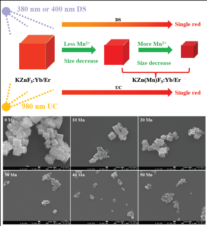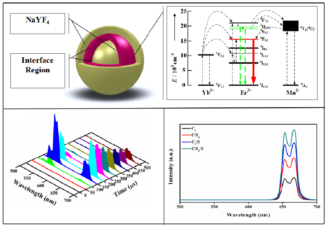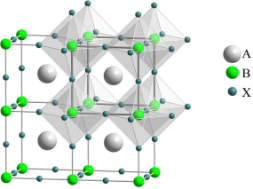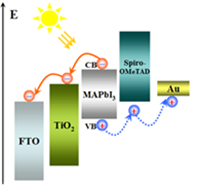Research Group on Luminescence Nanomaterials and Photovoltaic Materials
Research Directions:
1. Micro/Nano Luminescent Materials and Their Applications
Luminescent materials have been widely used in the fields of information display, lighting, imaging, laser and photoelectric devices due to the excellent performance, which play an increasingly important role in the development of society and the progress of technology. In this direction, we mainly study rare earth and transition metal ions doped inorganic luminescent materials, organic luminescent molecules and so on. We are devoted to obtain the materials with special luminescence properties and excellent light absorption and conversion properties, and apply it to biological fluorescence labeling and solar cell.
(1) A variety of rare earth doped upconversion nanomaterials were designed to prepare new nanostructures. Through ion doping, energy adaptation and structural optimization, single red emission materials with high quantum yield and good stability were obtained. Through surface modification, biological fluorescence labeling, fluorescence microscopy imaging for cancer cell diagnosis, real-time detection of various proteins and intercellular interactions in living organisms, thus providing a more effective means to understand the complex interaction and movement of biomolecules.
(2) The rare-earth ion doped upconversion and down conversion luminescence systems are used to modulate the spectrum with appropriate energy level matching mode and apply them to solar cells in various kinds of doping forms to solve the problems of short wave long ultraviolet light and long wave long red external light utilization, and make full use of the sun light to improve the photoelectric conversion efficiency of the battery.


2. Perovskite solar cells
Solar energy, as a new renewable energy, is inexhaustible and environment-friendly clean energy. Solar cell is one of the main ways of solar energy utilization. As the leading device of the new generation of solar cells, the perovskite solar cell has been paid attention by many researchers because of its suitable direct band gap, long carrier life, excellent electrical conductivity and efficient photovoltaic conversion efficiency. In this area, perovskite solar cell materials and devices are mainly studied.
(1) Inorganic hole transfer materials are designed and prepared. Organic hole transfer materials are expensive and not stable. Inorganic hole transfer materials are used to replace organic hole transfer materials and perovskite batteries are prepared. The cost can be reduced and stability can be improved. In this research group, copper based chalcogenide nanocrystals are used as hole transfer materials for perovskite batteries.
(2)Application of upconversion luminescent materials to perovskite solar cells. Perovskite solar cells can only absorb visible light, and can not absorb near infrared light. One way to solve the problem is to convert infrared light to the visible light which can be absorbed by the solar cells, which can improve the conversion efficiency of the solar cells.


Partial published papers:
(1) X.A. Zhang, B.H Wang, L.Z. Huang, W. Huang, Z. Wang, W.G. Zhu, Y. Chen, Y.L. Mao†, Antonio Facchetti†, Tobin J. Marks. Breath figure–derived porous semiconducting films for organic electronics. Science Advances 2020, 6(13):eaaz1042.
(2) J. Zhao, G.C. Pan, * W. Xu, S.Y. Jin, H.F. Zhang, H.P. Gao, M. Kang, Y.L. Mao*. Strong Upconverting and Downshifting Emission of Mn2+ ions in Yb,Tm:NaYF4@NaLuF4/Mn:CsPbCl3 core/shell Heterostructure towards Dual-model Anti-counterfeiting. Chem. Comm. 2020, DOI: 10.1039/D0CC05663D.
(3) W.B. Ma, Z.L. Zhang*, M.E. Ma, Y.F. Liu, G.C. Pan, H.P. Gao, Y.L. Mao*. CuGaS2 quantum dots with controlled surface defects as a hole-transport material for high-efficient and stable perovskite solar cells. Solar Energy 2020, 211: 55–61.
(4) F. Xu, H.P. Gao*, J.W. Liang, S.Y. Jin, J. Zhao, Y.F. Liu, H.F. Zhang, Z.L. Zhang, Y.L. Mao*. Enhanced upconversion luminescence in Cu1.8S@NaYF4: Yb@ NaYF4: Yb,Er core-shell nanoparticles. Ceramics International. 2019, 45: 21557–21563.
(5) J.Q. Qin, Z.L. Zhang*, W.J. Shi, Y.F. Liu, H.P. Gao, Y.L. Mao*. Enhanced Performance of Perovskite Solar Cells by Using Ultrathin BaTiO3 Interface Modification, ACS Applied Materials & Interfaces 2018,10(42): 36067-36074.
(6) J.W. Liang, H.P. Gao*, M.J. Yi, W.J. Shi, Y.F. Liu, Z.L. Zhang, Y.L. Mao*. β-NaYF4:Yb3+,Tm3+@TiO2 core-shell nanoparticles incorporated into the mesoporous layer for high efficiency perovskite solar cells. Electrochimica Acta 2018, 261: 14-22.
(7) M.J. Yi, Y.F. Liu, H.P. Gao, Z.Y. Huang, J.W. Liang, Y.L. Mao*. Upconversion effective enhancement of NaYF4:Yb3+/Er3+ nanoparticles by Ni2+ doping, Journal of Materials Science. 2018, 53(2): 1395-1403.
(8) W.J. Shi, Z.L. Zhang*, J.Q. Qin, Y.n Zhang, Y.Y. Liu, Y.F. Liu, H.P. Gao, Y.L. Mao*. Interface modification by up-conversion material of Ho3+-Yb3+-Li+ tri-doped TiO2 to improve the performance of perovskite solar cells. Journal of Alloys and compounds 2018, 754:124-130.
(9) X.L. Wang, Z.L. Zhang*, J.Q. Qin, W.J. Shi, Y.F. Liu, H.P. Gao, Y.L. Mao*. Enhanced Photovoltaic Performance of Perovskite Solar Cells Based on Er-Yb Co-doped TiO2 Nanorod Arrays, Electrochimica Acta 2017, 245: 839-845.
(10) J.F. Li, Z.L. Zhang, H.P. Gao, Y.Zhang, Y.L. Mao*, Effect of solvents on the growth of TiO2 nanorods and their perovskite solar cells. J. Mater. Chem. A, 2015, 3:19476.